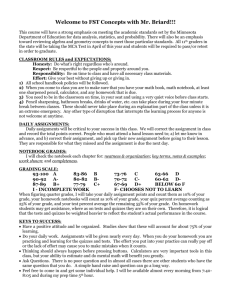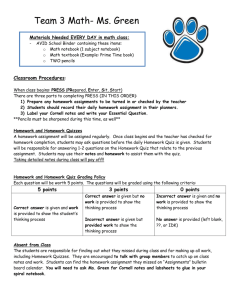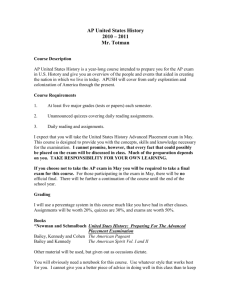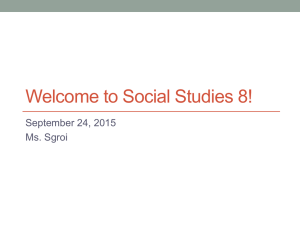File
advertisement
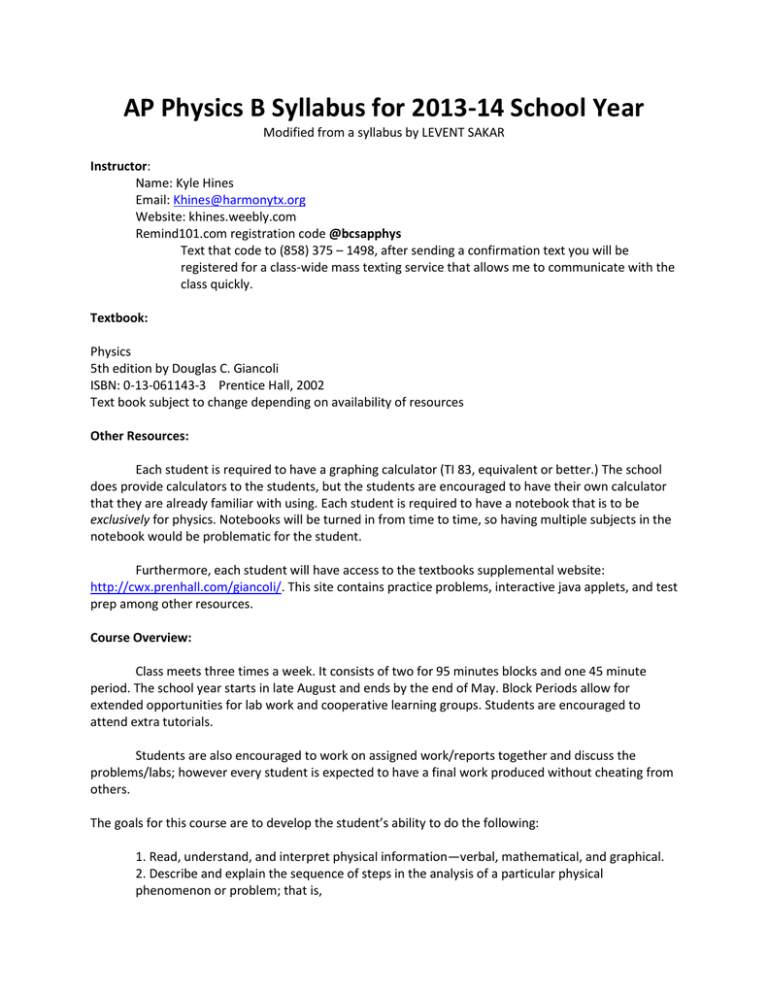
AP Physics B Syllabus for 2013-14 School Year Modified from a syllabus by LEVENT SAKAR Instructor: Name: Kyle Hines Email: Khines@harmonytx.org Website: khines.weebly.com Remind101.com registration code @bcsapphys Text that code to (858) 375 – 1498, after sending a confirmation text you will be registered for a class-wide mass texting service that allows me to communicate with the class quickly. Textbook: Physics 5th edition by Douglas C. Giancoli ISBN: 0-13-061143-3 Prentice Hall, 2002 Text book subject to change depending on availability of resources Other Resources: Each student is required to have a graphing calculator (TI 83, equivalent or better.) The school does provide calculators to the students, but the students are encouraged to have their own calculator that they are already familiar with using. Each student is required to have a notebook that is to be exclusively for physics. Notebooks will be turned in from time to time, so having multiple subjects in the notebook would be problematic for the student. Furthermore, each student will have access to the textbooks supplemental website: http://cwx.prenhall.com/giancoli/. This site contains practice problems, interactive java applets, and test prep among other resources. Course Overview: Class meets three times a week. It consists of two for 95 minutes blocks and one 45 minute period. The school year starts in late August and ends by the end of May. Block Periods allow for extended opportunities for lab work and cooperative learning groups. Students are encouraged to attend extra tutorials. Students are also encouraged to work on assigned work/reports together and discuss the problems/labs; however every student is expected to have a final work produced without cheating from others. The goals for this course are to develop the student’s ability to do the following: 1. Read, understand, and interpret physical information—verbal, mathematical, and graphical. 2. Describe and explain the sequence of steps in the analysis of a particular physical phenomenon or problem; that is, a. describe the idealized model to be used in the analysis, including simplifying assumptions where necessary; b. state the concepts or definitions that are applicable; c. specify relevant limitations on applications of these principles; d. carry out and describe the steps of the analysis, verbally or mathematically; and e. interpret the results or conclusions, including discussion of particular cases of special interest 3. Use basic mathematical reasoning—arithmetic, algebraic, geometric, or trigonometric, where appropriate—in a physical situation or problem. 4. Perform experiments and interpret the results of observations, including making an assessment of experimental uncertainties. Furthermore this course is developed to support and encourage the AP Physics tests instructional goals: 1. Physics knowledge—Basic knowledge of the discipline of physics, including phenomenology, theories and techniques, concepts, and general principles. 2. Problem solving—Ability to ask physical questions and to obtain solutions to physical questions by use of qualitative and quantitative reasoning and by experimental investigation. 3. Student attributes—Fostering of important student attributes, including appreciation of the physical world and the discipline of physics, curiosity, creativity, and reasoned skepticism. Grading policy: Semester grades will be based on the average of 2 Report Card grades. Report Card grades will be based on student work in given assignments. Assignments may include notebook checks, homework, class-work, quizzes, lab reports, and formal in class tests. It is the intention of the instructor to assign grades to any given assignment based on the expected time the student will need to complete the assignment and the importance that the instructor wants to give to that particular assignment. Notebook Checks: Students are required to have a notebook that is exclusively for physics. I will be checking this notebook at least twice per quarter. I will be looking for complete notes, diagrams, and worked examples. Neatness will affect your grade. Homework: There will be three homework assignments per chapter, one reading comprehension assignment given at the beginning of a chapter and two problem sets given at the middle and end of a chapter. Homework is due first thing on the second class after it is assigned. I will give out answer keys in class the day homework is due. NO HOMEWORK WILL BE ACCEPTED AFTER ANSWER KEYS HAVE BEEN HANDED OUT. If you have a half-finished homework the day it is due, it is strongly advised that you turn in what you have. Class-work: Occasionally, you will be expected to complete a problem set or a worksheet that is designed to reinforce your understanding of concepts. Class work assignments are expected to be completed and turned in before the end of class. Quizzes: Occasionally you will have quizzes, they will be short (between 3 and 5 problems) and you will know about them ahead of time. Lab reports: You will be performing labs regularly; occasionally I will require you to write a lab report to accompany a lab. Lab reports will be due 1 week after the completion of a lab. Your lab reports are to be completed according to the following format: Title - The title will be centered horizontally, and reflect the content of the report. Question - What are you trying to find out in the lab? Background - Background consists of definitions, prior knowledge, and/or related research that can be used to help answer the question and generate a hypothesis. Hypothesis - The hypothesis is a possible answer to the question. It is based on background knowledge and must refer back to the question. The hypothesis must be in the form of a statement, which can be specifically tested. It NEVER begins with the words, "I think." The format is: "If... Then... Because..." (Remember: No one can TEST what you think, feel, or believe!) Equipment - The equipment list should be a bulleted list of the equipment needed to perform the task. It should include anything someone might need to repeat the procedure. List the quantity and SI (metric) sizes needed when applicable. Procedure - The procedure is a numbered list of steps that another scientist can follow to reproduce the experiment. It can be in your own words, include diagrams, etc.; it must be clear enough that any person could reproduce the lab exactly by following your procedure carefully. Indicate reliability here (quality scientific investigations must be repeatable). Discuss issues of safety here. You need a first draft of your procedure before you begin work. Your first draft can be modified as you go, and changes or additions can be recorded and added to your final report. More elements are possible, but these elements MUST be present in your procedure: o At least one controlled variable o The manipulated variable o The responding variable o An indication of measurements being recorded o Validity measures (example: cleaning equipment between trials) o Repeated trials o Experimental control condition (control group) Data Section - Data includes pieces of information that you record during your investigation. Do not forget to record things that might affect the outcome (examples: temperature, weather, etc.). Your data must indicate which variables are controlled, manipulated and responding variables. A plan for collecting data, such as data table or list of things to record, should be in place before you begin. As with the procedure and equipment lists, you may change your mind about what to record during the investigation. In your final draft, have your data organized (rearranged, consolidated, summarized, etc.) to show patterns ore trends that led to your conclusion. Be careful to follow instructions given in lab activity, if it asks for a comprehensive data table is sure to include it separately along with the data from each trial. Remember: Science does not prove - it can only disprove existing explanations when large numbers of trials are done. Diagrams & Graphs - Include any diagrams, graphs and/or sketches that are appropriate for the lab activity. Calculations - Show all calculations used to determine unknown values in the lab activity. Clearly label each calculation to the part of the lab activity it pertains to. Related Questions - Answer completely with detailed explanation or diagrams. Conclusion - The conclusion should clearly restate your hypothesis, and show how your data has either supported or refuted you hypothesis. Be careful. Sometimes you may see patterns that are not connected to your question. This is OK, but your conclusion must be connected to your hypothesis. You should also include any places where experimental error might have occurred, or where you might have had difficulty. In other words... o What went right? o What went wrong? o What would you improve the next time? (Examples: additional trials, variables not controlled; additional questions that come up as a result of your research) o Use your range of data to indicate how it has supported or refuted your hypothesis. Indicate how your data (using actual data) has helped answer the question. A range of data (high and low points) should be presented with an explanation of how the given data supports or refutes the conclusion. Misquoting one or more data points is a serious but common error. Be very careful to report data correctly. Due to safety concerns, students are to adhere to lab safety contract all the time when they work on lab activities and experiments with no exception. Failure to do so may result in removal from lab and getting zero for the assignment and a parent conference. Tests: Each unit will conclude with an in class test. Tests will be composed of old AP test questions and will be worth 50% of the points for that unit. For example, if all of the homework, quizzes, classwork, and lab grades for a unit total 800 points, then the test for that unit will also be out of 800 points. Content outline: I. Newtonian Mechanics A. Kinematics (including vectors, vector algebra, components of vectors, coordinate systems, displacement, velocity, and acceleration) 1. Motion in one dimension 2. Motion in two dimensions, including projectile motion B. Newton’s laws of motion 1. Static equilibrium (first law) 2. Dynamics of a single particle (second law) 3. Systems of two or more objects (third law) C. Work, energy, power 1. Work and work–energy theorem 2. Forces and potential energy 3. Conservation of energy 4. Power D. Systems of particles, linear momentum 1. Impulse and momentum 2. Conservation of linear momentum 3. Elastic and inelastic collisions E. Circular motion and rotation 1. Uniform circular motion 2. Torque and rotational statics F. Oscillations and gravitation 1. Simple harmonic motion (dynamics and energy relationships) 2. Mass on a spring 3. Pendulum and other oscillations 4. Newton’s law of gravity 5. Orbits of planets and satellites (Circular) II. Fluid Mechanics and Thermal Physics A. Fluid Mechanics 1. Hydrostatic pressure 2. Buoyancy 3. Fluid flow continuity 4. Bernoulli’s equation B. Temperature and heat 1. Mechanical equivalent of heat 2. Heat transfer and thermal expansion C. Kinetic theory and thermodynamics 1. Ideal gases a. Kinetic model b. Ideal gas law 2. Laws of thermodynamics a. First law (including processes on pV diagrams) b. Second law (including heat engines) III. Electricity and Magnetism A. Electrostatics 1. Charge and Coulomb’s law 2. Electric field and electric potential (including point charges) B. Conductors, capacitors, dielectrics 1. Electrostatics with conductors 2. Capacitors a. Capacitance b. Parallel plate C. Electric circuits 1. Current, resistance, power 2. Steady-state direct current circuits with batteries and resistors only 3. Capacitors in circuits D. Magnetic Fields 1. Forces on moving charges in magnetic fields 2. Forces on current-carrying wires in magnetic fields 3. Fields of long current-carrying wires E. Electromagnetism 1. Electromagnetic induction (including Faraday;s law and Lenz’s law) IV. Waves and Optics A. Wave motion (including sound) 1. Traveling waves 2. Wave propagation 3. Standing waves 4. Superposition B. Physical optics 1. Interference and diffraction 2. Dispersion of light and the electromagnetic spectrum C. Geometric optics 1. Reflection and refraction 2. Mirrors 3. Lenses V. Atomic and Nuclear Physics A. Atomic physics and quantum effects 1. Photons, the photoelectric effect, Compton scattering, x-rays 2. Atomic energy levels 3. Wave-particle duality B. Nuclear physics 1. Nuclear reactions (including conservation of mass number and charge) 2. Mass–energy equivalence Classroom policies regarding electronic devices Cell phones, digital cameras, iPhones, iPods etc are not allowed in the classroom. While having their use, they have significantly added to the distraction of students. Texting and engaging in silent conversations when students should be fully engaged in their lesson has severely impacted our teaching and student learning. I am asking students to leave their cell phones in their lockers and do NOT bring iPods or gaming devices to school. All or any of the above will be taken from the student if discovered by the teacher and can only be retrieved from Mrs. Jones’ office after paying the $10 fine. Refer to school policy for more details on this matter. If any student should experience a personal emergency they will be allowed to use the phone at the main office or counselors’ suite. Classroom Rules: Violations will result in disciplinary action ● ● ● ● ● ● ● ● Show respect for others. No verbal, physical, or body language abuse will be tolerated. Do not talk while the teacher or a student is speaking. (Once you finish a test, do not talk while others are testing. Talking while others are testing may be perceived as cheating.) Raise your hand to answer or ask questions. Always be in your assigned seat. Do not leave your assigned seat without permission. Refrain from defacing desks, tables, walls, floors, posters, etc.; throwing objects, bringing electronic devices or any behaviors that result in interference with learning. Refrain from eating, drinking, chewing any substance. This is a safety issue and any violations will count against your safety grade. Refrain from touching any equipment unless instructed to do so by the teacher. No sleeping in class. Discipline Policy Violating the above rules will result in the following consequences: Student will receive a verbal warning from the teacher clarifying the rule they are violating. Student will receive a written warning on the board, which will remain there until the end of class. Student will receive a check mark next to their name. This signifies a 30 min detention to be served according to the teacher’s expectations. Student will receive a 2nd check mark. This signifies that DPS points will be given and the parents will be notified. Student will be removed from the classroom. Student will be sent to a neighboring classroom to reflect on their actions and/or calm down. Students will still be responsible for completing any assignments given during this time. Students will still be accountable for learning the material covered during this time. Consequences will be applied in the order that they are written expect for under the following circumstances: If a student has served 5 detentions in one quarter, then the detention phase will be skipped and student will automatically have DPS points assigned to them. Severe infractions (fighting, horseplay, unsafe behavior, etc) will result in the automatic removal of the student for the safety of all. Chronic or severe infractions will result in a referral to Mrs. Jones’ office and a parent/teacher conference. Classroom Procedures & Daily Routines The student will: ● ● Have a positive attitude all the time! Be polite, be supportive. Bring all required materials to class daily. No returning to your locker- you will receive a tardy. Three tardiness results in one detention. ● ● ● ● ● ● ● ● In your first step to class, greet your teacher; in your second step, start to read the Daily Agenda. Be in your seat and ready to work before the tardy bell rings (or you will be marked tardy). If there’s no HW to turn in and no Physics Warm-up Assignment posted, start to work on your daily Mental-Math assignment. Be responsible for one's own property and behavior. Observe and follow rules stated in the student handbook. Turn in work on time. Deadlines are deadlines. Know that the bell doesn’t dismisses the class, the teacher does. If/When bell rings, wait for last instructions from the teacher. When the teacher dismisses the class, move the chair under its desk and walk slowly to the door. This class requires dedication and an immense amount of study time. You will get out of this class only what you are willing to contribute! Students are expected to read required chapters in textbook prior to class discussion. (Note: Quizzes on required readings may be unannounced so make sure you are completing the readings.) All assignments must have a complete heading (full name, date, subject, and assignment title). Failure to write your name on an assignment will result in a minimum 5 point deduction. Restroom policy All students will be given a sheet of restroom passes every quarter. You are allowed to use each period’s ticket 3 times in a quarter. If you need the restroom you are to ask permission, bring me your sheet, and sign out at the door. Remember to sign in when you return. Your ticket is your hall pass. If you lose your tickets you cannot go to the restroom. You may NOT use another student’s tickets. If you have a medical situation that requires frequent restroom use, please inform me in private and provide a doctor’s note. Special accommodations will be given. Academic Honesty As explained in the student handbook, cheating is defined as “giving or receiving in any form, information relating to a gradable experience, either during or outside class.” Violations of the honor code will result in a zero for the assignment. Read the student handbook carefully to fully understand what constitutes an honor code violation. Upon teacher request, students may be required to email essays, research papers, or other written work. Grade Maintenance Students are expected to maintain their grades at or above 75% at all times. In the event that a student’s grade falls below 75%, the student will be warned the first time. The second time this happens the student will attend mandatory tutoring. If this happens for a third time, the parents will be contacted.
